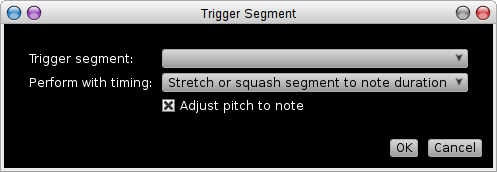Segments déclenchés
Un segment déclenché est un segment qui n'apparait pas dans le canevas principal des segments. Il n'est pas positionné à un temps précis ni classiquement lié à un instrument. Ce type de segment particulier est, comme son nom l'indique, déclenché durant la lecture de la composition par une ou plusieurs notes. Cette note ou ces notes “déclencheuses” permettent l'appel de la lecture de l'ensemble du segment déclenché. L'appel du segment déclenché dans une composition correspond par exemple aux ornements tels que la notation des trilles. Dans une telle situation, la trille (segment déclenché) est jouée à la place de la note porteurs de cet ornement. Un des usages classiques du segment déclenché correspond au rendu de certains ornements (tmp).
La gestion des segment déclenchés est accessible à partir du menu Segment → Gérer les segments déclenchés de la fenêtre principale de Rosegarden. Pour créer un nouveau segment :
- Copier un segment ou une partie de segment existante. Cette copie peut être effectuée dans n'importe quel segment existant ou créé temporairement pour cette simple copie. En effet, une fois défini en tant que segment déclenché, le lien avec la source de la copie n'existe plus.
- Une fois cet ensemble de notes dans le presse papier, utiliser la fonction Éditer → Coller en tant que nouveau segment déclenché dans le gestionnaire de segment déclenchés.
- Le segment déclenché défini, ce dernier est accessible pour être joué en lieu et place d'une ou plusieurs notes (sélectionnées) dans un segment classique. L'appel du segment déclenché peut se faire de deux façon différentes :
- Dans l'éditeur matriciel : Ajuster → Segment déclenché…
- Dans l'éditeur de partition : Note → Ornement → Ornement déclencheur…
Rosegarden can optionally stretch or squash each triggered segment to match the duration of the note that triggers it, and can raise or lower the pitch and velocity of the segment likewise to match. A triggered segment is played on the same instrument as its triggering event.
When triggering a segment, you will be offered a choice for how it is played in terms of timing, because the triggered segment (or ornament) may have a different underlying duration from your triggering note. The options for playback timing are:
As stored
Play the triggered segment with a start time coinciding with that of the note, and at the original speed. Keep playing the triggered segment until it ends, even if it is longer than the triggering note.
Truncate if longer than note
Play the triggered segment with a start time coinciding with that of the note, and at the original speed. If the triggered segment is longer than the triggering note, truncate it so that it ends at the end time of the note.
End at same time as note
Play the triggered segment with its end time coinciding with the end of the note, and at the original speed. This means the start of the triggered segment may be chopped off if it is longer than the triggering note.
Stretch or squash segment to note duration
Speed up or slow down the triggered segment so that it fits exactly into the duration of the triggering note. This is the default.
A triggered segment may contain silence at the start or end, and this will be “played” (and stretched or squashed if appropriate) as well as the notes and other events in the segment.
It is not currently possible to make a triggered segment start playing before the start time of its triggering note. You also can't trigger a segment from within another triggered segment, and you can't trigger audio segments.
To edit the contents of a triggered segment, either double-click on it in the manage triggered segments window, or double-click on any note that triggers it. Apart from editing the notes in the segment, you can also change the duration of the segment itself from the Edit menu of the resulting event list view. Remember that editing a triggered segment will affect all the notes that trigger it, not just the one that you double-clicked to get to the editing window.
2] For reference, Rosegarden uses a frequency-domain time-stretcher based on a phase vocoder with phase-locking at percussive transients. This usually produces good results with stable harmonic sounds such as pads and basses as well as purely percussive sounds such as drum loops, but is less effective for composite material or music with soft or breathy note onsets.
